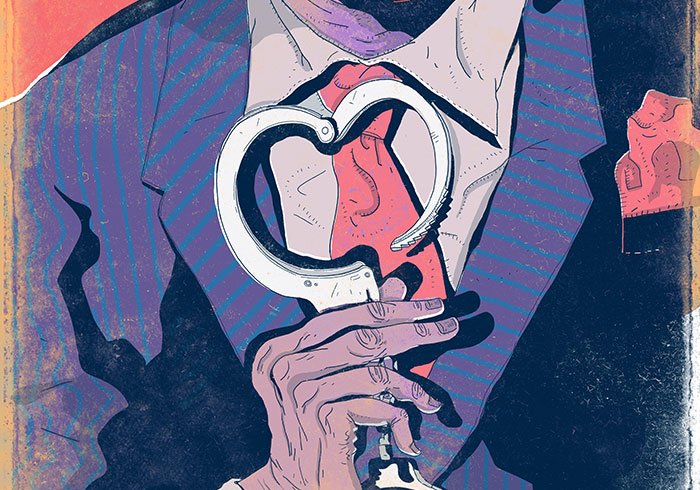In February 1993, Canada’s crime rate stood at an all-time high, Brian Mulroney was prime minister, and a Conservative-dominated House of Commons committee released a report on crime prevention that held no surprises for those who followed criminal justice policy. It described the “inherent inadequacy of the criminal justice system” as a means of addressing the problem, pointing out: “If locking up those who violate the law contributed to safer societies then the United States should be the safest country in the world. In fact the United States affords a glaring example of the limited impact that criminal justice responses may have on crime…. Evidence from the U.S. is that costly repressive measures alone fail to deter crime.”
The committee chair, Conservative Member of Parliament and former RCMP officer Bob Horner, told the press, “If anyone had told me when I became an MP nine years ago that I’d be looking at the social causes of crime, I’d have told them that they were nuts. I’d have said, ‘Lock them up for life and throw away the key.’ Not any more.”
Skepticism about the idea that imprisonment constitutes a good solution to the crime problem began decades before these stark statements. In 1938, for example, a Royal Commission examining the country’s penal system concluded: “The undeniable responsibility of the state to those held in its custody is to see that they are not returned to freedom worse than when they were taken in charge. This responsibility has been officially recognized in Canada for nearly a century but, although recognized, it has not been discharged. The evidence before this Commission convinces us that there are very few, if any, prisoners who enter our penitentiaries who do not leave them worse members of society than when they entered them.”
We now know, quite conclusively, that the commission was correct. Though necessary in some cases, imprisonment has limited usefulness and does not rehabilitate. Three decades later, in 1969, a blue-ribbon, federally appointed committee came to the same conclusion: “In all cases where there has been no finding of dangerousness, sentences of imprisonment should be imposed only where protection of society clearly requires such a penalty…. The Committee wishes to emphasize the danger of overestimating the necessity for and the value of long terms of imprisonment except in special circumstances.”
Over the years, the tension between what was seen as good policy and actual practice led many independent committees and commissions to examine how we could create a criminal justice system that better reflected Canadian values. However, it was not until 1982, after a decade of study by the Law Reform Commission of Canada, that the federal government wrote a formal statement of criminal justice policy, which it hoped would act as a guide for the development of our criminal law. Released under the signature of then minister of justice and future prime minister Jean Chrétien, its major theme was simple: “[The] approach calls for restraint to be employed in the use of criminal law and the criminal justice system, on the basis of a conception of the criminal law as the ultimate point along the spectrum of society’s informal and formal methods of dealing with conduct…. In awarding sentences, preference should be given to the least restrictive alternative adequate and appropriate in the circumstances.”
Not surprisingly, the statement met with little criticism. Indeed, Globe and Mail columnist Michael Valpy complained that no serious person could disagree with it, because it contained nothing more than “a discussion of only very broad notions about crime and society and a set of principles which fall into the region of motherhood.”
The Liberals lost power to the Conservatives in 1984, and in 1988, just before the end of Brian Mulroney’s first term, a parliamentary committee released a 300-page report that endorsed many of the views expressed in the Liberal statement six years earlier. The 1988 committee was dominated by the majority Conservatives and chaired by Conservative MP David Daubney. Conservative MP Bill Domm, who had spearheaded the attempt to restore capital punishment in 1987, was a committee member. Rob Nicholson, who nineteen years later would be appointed Stephen Harper’s second minister of justice, served as vice-chair. Its conclusion differed little from that of the Liberals. “Carceral sentences,” it said, “should be used with restraint; there must be a greater use of community alternatives to incarceration where appropriate, particularly in cases not involving violence or recidivism.”
A year later and now in its second term, the Conservative government reprinted and re-released the Liberals’ 1982 report, the one Valpy had characterized as “motherhood,” making no changes other than to remove the page with Jean Chrétien’s signature. In the 1980s, apparently, Liberals and Conservatives shared the same criminal justice mother.
In 1990, the Conservative government issued a comprehensive plan for sentencing and corrections, under the signatures of Solicitor General Pierre Cadieux; and Attorney General, minister of justice, and future Conservative prime minister Kim Campbell. Once again, its policy statements were broadly indistinguishable from the previous Liberal recommendations. Indeed, the report on sentencing—described as “the thinking of the federal government about this very complex issue”— explicitly endorsed the 1982 policy statement, concluding that imprisonment should only be used to protect the public from violence, when a non-custodial sentence could not be devised that would reflect the seriousness of the case, or if an offender refused to comply with a non-prison sentence. The proposals on corrections reflected the single most important fact about prisons, namely that most inmates will return to live in our communities: “The fundamental purpose of the correctional system is to contribute to the maintenance of a just, peaceful and safe society through the safe custody and control of offenders and their reintegration into the community as law-abiding citizens.”
From the 1960s until the early 1990s, then, Liberals and Conservatives agreed that the criminal justice system was designed to respond to crime, and to determine who should be held accountable and how they should be punished. They also agreed that it has almost no effect in controlling crime rates, which are largely a function of social policies and other factors outside the control of the justice system. Even in the face of rising incarceration, successive Liberal and Conservative governments stayed the course. Imprisonment statistics had remained relatively stable until 1972, when they began moving slowly upward—from eighty-two adult inmates per 100,000 Canadian residents that year to 114 in 1996. But the increase was modest, compared with that in the United States, where the 1996 rate (618 inmates per 100,000 residents) was approximately four times the number for 1972. And because neither the Liberals nor the Conservatives favoured more imprisonment, Canada’s response to its growing prison population was to set up a federal-provincial-territorial task force to make recommendations on how to curtail it. These were endorsed, in 1996, by all governments, including those of Conservative premiers Mike Harris in Ontario and Ralph Klein in Alberta.
This is not to say that governments always acted with restraint. In 1994, Jean Chrétien’s Liberal government introduced a comprehensive sentencing bill, which yet again proposed that imprisonment should be employed sparingly. Before the bill passed, however, the government introduced the largest set of mandatory minimum penalties in Canadian history: mandatory minimum sentences of four years in prison were inserted into the Criminal Code for ten different violent offences carried out with firearms. The government also made it more difficult for those convicted of murder to get parole. Both of these changes broke with the past, and both were politically motivated. The mandatory minimums were part of the contentious, and now dead, long-gun registry bill, and were apparently designed to make firearm registration more palatable. The changes to parole eligibility were a response to victims’ demands, and serial murderer Clifford Olson’s attempt to obtain an early parole hearing. This was the onset of “tough on offender” politics in federal criminal justice policy, although the amendments were seen as the exception rather than the rule. And this same Liberal government introduced legislation in 1999 that, when it became law in 2003, significantly reduced youth incarceration.
The election of Stephen Harper’s Conservatives in 2006 dramatically changed the focus of criminal justice policy in Canada. Suddenly, harsher punishment became the preferred solution to crime, which had been declining for about fifteen years. New mandatory minimum sentences were created, others were lengthened, and the use of certain non-prison sanctions was restricted. There are two explanations for the government’s desire to make the criminal justice system more punitive. The first is obvious: “tough on offenders” bills seem popular, and they constitute an easy sell to the government’s conservative base. The second is improbable: that the government actually believes the best way to reduce crime is to increase punishments.
Imprisoning a few thousand more people may prevent the few street crimes they might have committed had they not been incarcerated, but what about the impact of imprisonment on the chances of their reoffending after release? The data comparing recidivism rates for former inmates with those for offenders given non-prison punishments demonstrates conclusively that incarceration does not decrease reoffending. In fact, for some offenders—notably those sent to prison for the first time—it may increase it. Averting a few crimes while convicts serve their sentences in prison doesn’t help if more crimes are committed when they are released.
But this is not about policy; it’s about politics. Advocating for “tough on offenders” bills makes for good bumper stickers and sound bites, even if it violates one of the government’s economic principles: that public money should not be spent on programs that do not advance its stated goals. Keeping a single inmate in federal penitentiary costs about $117,000 per year; a provincial inmate about $58,000. Money spent on incarceration is money not spent on services (the police, education, public health, and so on) that the evidence suggests would be more effective at reducing crime.
What is at stake, however, is much more important than imprisonment rates. Between 2006 and 2011, when it achieved a majority, the Harper government introduced an incoherent torrent of sixty-one separate criminal justice bills, a virtual tsunami of punishment. While many of these bills never became law, they imposed a view of offenders that constitutes a fundamental break with the country’s past. To focus solely on the fact that the government made some penalties harsher is to miss the point: it wants to change the way Canadians view wrongdoers. In the government’s eyes, the world is simple: there are “bad” people (those who have broken the law), and there are “good” people (everyone else).
Unfortunately, this view ignores estimates that about a quarter of a million Canadians are found guilty of criminal offences each year. At least 2.4 million have criminal records. Studies show that most youths commit some kind of offence, and that many adults have driven while legally impaired or have smoked marijuana. Some 20 percent of Ontario taxpayers admit to having committed the offence of tax evasion, either by knowingly not reporting income, or by claiming business expenses they know not to be legitimate. Committing crime, then, is not an exceptional activity, and policies based on the notion that “once a criminal, always a criminal” reflect a fundamental misunderstanding.
Since 1970, Canadians convicted of most criminal offences have been eligible to apply for pardons. The theory is simple: people make mistakes and should not be required, after years or decades of living crime-free, to pay a price for what may have been a youthful indiscretion. Why, for instance, should former offenders, having been punished and gone on to become good citizens, be denied access to certain jobs? “Forever” rules are inherently blunt and unfair. A pardon allows people to go about their lives without the burden of a criminal past, to give them an opportunity to get out from under the shadow of their mistakes. Research shows that after a few years without committing a crime, former offenders are no more likely to do so than those in the general population. To put it another way, people do change.
It might have made sense to look at pardons in light of what is now known about offending patterns and the successes and failures of previous legislation. Instead, the Harper government simply imposed its “tough on offenders” agenda, starting with the word “pardon” itself. The government prefers the term “record suspension,” which sends the message that anyone who once committed a criminal act will never again be a full member of Canadian society. In December 2010, it raised the pardon application fee from $50 to $150. Then, two months later, Public Safety Minister Vic Toews announced that he would raise it again, this time to $631, saying, “We believe that ordinary Canadians shouldn’t have to be footing the bill for a criminal asking for a pardon.” The contrast is telling: ordinary Canadians versus criminals.
Since 1908, Canada has ensured the anonymity of almost all youths who come in contact with the criminal justice system. It does this for a simple, empirically sound, reason: it has not wanted them to be forever labelled as criminals for mistakes they made as youths. This, too, the Harper government has undone: its 2011 omnibus crime bill gives judges the power to permit the publication of the names of youths who commit any violent offence, including minor assaults, thus ensuring that they will forever be identified as “bad.” Is it in the public interest to make known the identity of someone who does something stupid when he or she is fifteen? Not really; one reason we have a separate youth justice system is that we understand that criminal behaviour is something young offenders will likely outgrow.
The government is also making it more difficult for those convicted of criminal offences abroad to serve their prison sentences in Canada. Canadians incarcerated in another country are typically deported back to Canada at the end of their sentences, having been denied access to rehabilitation programs in the foreign country (most often the US). An alternative is a program that has existed since 1978, which allows Canadians who offend abroad to serve their sentences in Canadian penitentiaries, where they have access to rehabilitation programs, and are closer to family and friends who can help them reintegrate into society. And when they are released, conditions can be placed on them to ensure that they become law-abiding citizens. The Harper government has changed the law to enable the public safety minister to block prisoner transfers more easily, presumably to keep these “bad” people out of the country for as long as possible. The irony is that after serving their sentences abroad, they are usually deported to Canada, to live in communities without the support or supervision they would receive after being released from a Canadian penitentiary. Thus, over the long term, the change in the law may increase the chances that a Canadian convicted elsewhere will reoffend in Canada.
When people are convicted of murder in Canada, they are automatically sentenced to life in prison. After twenty-five years, a person convicted of first-degree murder can apply for parole. A conviction for second-degree murder also results in an automatic life sentence, but these offenders must wait at least ten years—and up to twenty-five if the judge so orders—before they can apply for parole. If paroled, the offender lives forever under conditions set by the Parole Board of Canada, the breaking of any one of which can result in a return to penitentiary. In 1976, when capital punishment was abolished, there was concern that the upper end of this parole ineligibility period would discourage all hope of reintegration as a law-abiding citizen. The so-called faint hope clause allowed a jury of twelve ordinary citizens to reduce the ineligibility period to fifteen years or more for some inmates serving life sentences for murder—those whom the jury unanimously deemed safe and deserving. The parole board would still have the prerogative to decide whether or not to release them.
Pursuing their “tough on offenders” agenda, the Conservatives abolished the faint hope clause in 2011. But to what end? In the past five years, an average of 4.8 people a year were released under the provision. In 2010–11, there were two. Why would the government be concerned with the release of four or five prisoners a year, when in 2010 1,556 people serving life sentences were living in our communities under controls imposed by parole? The majority of these did not benefit from the faint hope clause.
The government’s decision to abolish the faint hope clause cannot be justified in terms of public safety. Almost all of the living offenders released by way of the faint hope provision are living peacefully in our midst. And it can’t be justified in terms of public acceptability, since each release had to be approved by a jury of ordinary people chosen from the community, and by a parole board. Clearly, the government wanted to extinguish hope, however faint. In that, it no doubt succeeded.
Before 2006, Canadian governments understood that when people who do bad things are held accountable, they often become trusted members of society. For over half a century, Liberal and Conservative governments saw it as their role to bring offenders back into society. For generations, Canadians have understood that legal condemnation is a necessary but terrible instrument, to be used sparingly, not wantonly. All of this the Harper government has rejected, in a calculated attempt to change the way Canadians see one another. At some point in our lives, most of us have done things we’re not proud of. But if offenders are, as the government sees them, fundamentally bad and incapable of change, then they should be forever excluded. They are not like the rest of us. They are the enemy.
Looking back, it becomes clear how profound these changes truly are. In 1971, Solicitor General Jean-Pierre Goyer, a Liberal, made a statement in the House of Commons about the need to reform how Canada runs its penitentiaries. “For too long a time now,” he said, “our punishment-oriented society has cultivated the state of mind that demands that offenders, whatever their age and whatever the offence, be placed behind bars. Even nowadays, too many Canadians object to looking at offenders as members of our society, and seem to disregard the fact that the correctional process aims at making the offender a useful and law-abiding citizen, and not anymore an individual alienated from society and in conflict with it…. We will undoubtedly have to keep protecting society against dangerous criminals, but we will also take into consideration the fact that most inmates do not belong to such a category…. [An] inmate is always a citizen who, sooner or later, will return to a normal life in our society, and as such is basically entitled to have his human dignity, of course, but also his rights as a citizen respected by us to the largest possible extent.”
The Conservative justice critic at the time, Alberta MP Eldon Woolliams, had no trouble with Goyer’s admonition. Indeed, he agreed with the Liberal minister’s statement, saying that he wanted “to congratulate the minister for realizing at last that crime is not just a sordid happening but rather a result of human behaviour brought about by our economic and social conditions which we have failed to change…. We are dealing with a matter which is above politics.” He concluded his response to the Liberal policy statement by saying he hoped the Solicitor General would “translate his words into action in order to relieve the terrible frustrations of the convicted and to change our prisons from factories of crime to factories of rehabilitation and prevention of crime.”
More than forty years after Goyer, a Liberal, and Woolliams, a Conservative, stated these core values, the Harper government is trying to change them. This raises the question: if Canada’s reasonable and humane crime policies have historically been representative of Canadian values, then whose values does the Harper government believe it represents? Apparently, only its own.
This appeared in the September 2012 issue.





